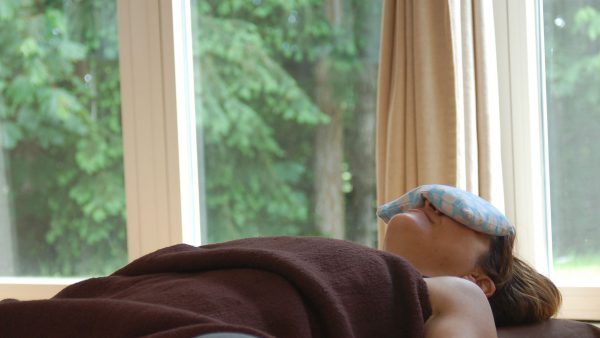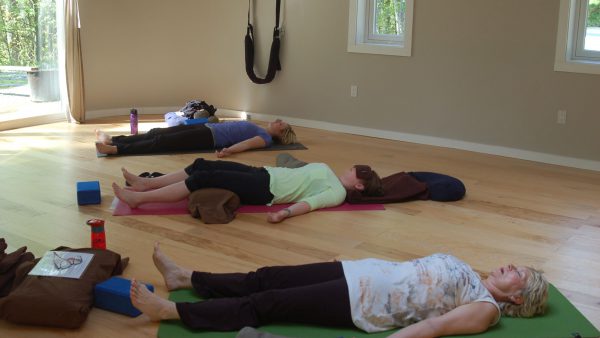INFRARED HEAT FOR ANY
YOGA STYLE
Infrared Heat for Any Yoga Style
Infrared Heat is not only a safe healthy way to heat your yoga studio, it is an effective heating method for any style of yoga. Dr. Black Primary Director and Yoga Teacher Trainer of Heat to Heal™ has used infrared in her yoga studios for the past five years and has found the best temperatures and methods for teaching each individual yoga style.
Comfort of your students is your number one priority. When students are comfortable, warm, and safe they experience greater benefits from their yoga and meditation practices. The soft warm breathable heat of an infrared studio removes much of the distraction inherent in traditional heating and cooling practices. While heated floors are a wonderful option in a studio, overhead or side fitted walls of infrared heat will ensure the floors are a comfortable place for your students.

Yoga Nidra
When practicing Yoga Nidra (Yogic Sleep) it is essential that students are warm. As many Yoga Nidra practices incorporate a variable of temperature opposites, often students may feel the “cold” component too cold and begin shivering. Comfort of position both with their yoga mats, bolsters, and blankets ensure a restful Yoga Nidra Practice. We suggest you heat the room to between 30-40C.

Restorative Yoga
As with Yoga Nidra, Restorative Yoga practices are best completed in a heated room; however, pay close attention to the needs of your students. Menopausal women will not do well if the room is overheated. This is where having infrared will help your students find greater comfort in their practices. We find at Heat to Heal™ that many students choose to not use blankets during their practices when the overheat heat is set between 35-45C.
Yin Yoga
In Yin Yoga the intent is to have deeper benefits at the facial or deep tissue levels. The warmer the room, the deeper the practice can become. Heating with infrared leads to safer Yin practices. We suggest heating between 40-50C for these practices and cooling the room down during the final shavasana.
Hatha Yoga
Hatha Practices are as varied as students and instructors. This practice is best determined by individuals and intensity of practice. Some studios incorporate a “cool studio” hatha practice and others a “hot studio” practice. The beauty of infrared heat is that it heats objects, not the air, so if you are offering a “hot practice” immediately followed by another class of “cool hatha” the room will cool off quickly to basic room temperatures as soon as your turn off the heat and the students leave the room. A door ajar or small window opened will cool the room off to a comfortable level as your “cool” students start their class. Room temperature heat is desirable for a cool class and you only need to heat your studio enough with infrared to reach this desirable temperature for your students. We find a “warm hatha” the most comfortable for our students and set the infrareds to between 30-40C.
Vinyasa Flow
Safety is the number one concern for Vinyasa Flow practices. Warm, soft heat is beneficial for the opening of practices to help the body begin to use it’s own internal sources of heat. Again, we encourage you to use your students as your guide for what is the most comfortable room temperature for these practices. What you don’t want is students slipping or losing their balance from overly sweaty bodies. We will often turn the heat on for the opening of the session, turn it off for the standing poses and then turn it on again for the seated or restorative closing sections of the class. We usually do not bring the heat over 30C for these types of classes.
Ashtanga Vinyasa Practices
Classical Ashtanga Vinyasa Practices are best done at a regular room temperature with a towel kept close to wipe off any additional body sweat to prevent slipping in balancing poses or binds. We will use our infrared heat at the beginning of class to help students find a comfortable start to their practice and establish their ujjayi breathing bandha engagement to produce internal heat, then we’ll turn the heaters off until the end of practice and use it only for the final shavasana stage. Again using a temp of 30C is sufficient for this practice and may be too hot for some practitioners.
Bikram & Hot Yoga
Traditional Bikram and Hot Yoga Practices are conducted in a very hot room. It is not uncommon for some studios to heat their studios to well over 100 degrees F or even 45-50C. Unfortunately, when heated with traditional forced air these studios become dangerous in that students cannot breathe and will dramatically overheat. Infrared Heat is an ideal heat for these practices in that it helps the individual student body to heat in a safe manner and students are able to breathe easily. We suggest using your infrared set at around 40-45 for these practices and turning the heat off in the final shavasana stage to ensure the body comes back to room temperature before students exit the studio.
Power Yoga
Power Yoga practices again depend on student and instructor preference. We caution against having too hot of a studio for these practices as students can overstretch and push too hard in a hot environment. Ensure your students are comfortable and protected and you will find the practices improving.
